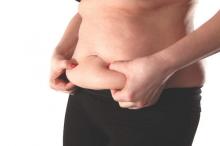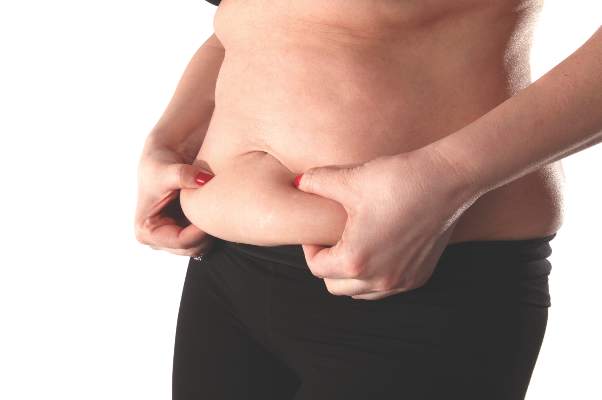User login
KISSIMMEE, FLA. – Eight treatments with a noninvasive radiofrequency device reduced unwanted abdominal fat by an average of 428 cc in a prospective study.
“Can we consider this permanent fat loss? Yes, if a healthy lifestyle is maintained,” said Dr. Diane Duncan of Plastic Surgical Associates in Fort Collins, Colo. “I think the best candidates for these treatments are thin to modestly overweight patients, because while we did see significant fat reductions in obese patients, they want all their fat gone, and this won’t do that,” she said at the annual conference of the American Society for Laser Medicine and Surgery.
The study assessed the effects of the BodyFX device (Invasix, Yokneam, Israel) on 19 women aged 20-65 years who had localized abdominal adiposity, with body mass indices ranging from 18 to 30 kg/m2. Dr. Duncan used an energy setting of 42 watts until the target area reached 41° Celsius, which typically took 3-5 minutes, she said. Then she administered high-voltage pulses of oscillating radiofrequency waves in order to create holes in the cell walls of adipocytes, which triggered gradual cell death.
After adjusting for age and height, eight treatments with the device led to a 53% decrease in abdominal fat thickness at a 3-month follow-up visit, Dr. Duncan reported. “Visual results were similar to liposuction,” she added. “But generally, not much change was noted before the fourth treatment.”
The analysis included sequences of three-dimensional Vectra ultrasound measurements, which were taken at four sites around the abdomen at the moment when patients reached their maximum exhale, Dr. Duncan said. She excluded two patients from final analyses because they had gained or lost more than 5 pounds, compared with baseline.
“I think the mechanism of action of this device is what makes it so special,” said Dr. Duncan. Scanning electron microscope photographs showed that adipocytes treated with the radiofrequency device underwent pyroptosis, which combines programmed cell death with the proinflammatory features of necrosis. That process stimulates formation of new collagen, resulting in localized skin tightening, she noted. “These new SEM data show a different and more beneficial process is taking place,” she explained. “Apoptosis, by definition, would not stimulate neocollagenesis, so no tissue tightening would occur.”
Dr. Duncan reported no funding sources or relevant financial disclosures.
KISSIMMEE, FLA. – Eight treatments with a noninvasive radiofrequency device reduced unwanted abdominal fat by an average of 428 cc in a prospective study.
“Can we consider this permanent fat loss? Yes, if a healthy lifestyle is maintained,” said Dr. Diane Duncan of Plastic Surgical Associates in Fort Collins, Colo. “I think the best candidates for these treatments are thin to modestly overweight patients, because while we did see significant fat reductions in obese patients, they want all their fat gone, and this won’t do that,” she said at the annual conference of the American Society for Laser Medicine and Surgery.
The study assessed the effects of the BodyFX device (Invasix, Yokneam, Israel) on 19 women aged 20-65 years who had localized abdominal adiposity, with body mass indices ranging from 18 to 30 kg/m2. Dr. Duncan used an energy setting of 42 watts until the target area reached 41° Celsius, which typically took 3-5 minutes, she said. Then she administered high-voltage pulses of oscillating radiofrequency waves in order to create holes in the cell walls of adipocytes, which triggered gradual cell death.
After adjusting for age and height, eight treatments with the device led to a 53% decrease in abdominal fat thickness at a 3-month follow-up visit, Dr. Duncan reported. “Visual results were similar to liposuction,” she added. “But generally, not much change was noted before the fourth treatment.”
The analysis included sequences of three-dimensional Vectra ultrasound measurements, which were taken at four sites around the abdomen at the moment when patients reached their maximum exhale, Dr. Duncan said. She excluded two patients from final analyses because they had gained or lost more than 5 pounds, compared with baseline.
“I think the mechanism of action of this device is what makes it so special,” said Dr. Duncan. Scanning electron microscope photographs showed that adipocytes treated with the radiofrequency device underwent pyroptosis, which combines programmed cell death with the proinflammatory features of necrosis. That process stimulates formation of new collagen, resulting in localized skin tightening, she noted. “These new SEM data show a different and more beneficial process is taking place,” she explained. “Apoptosis, by definition, would not stimulate neocollagenesis, so no tissue tightening would occur.”
Dr. Duncan reported no funding sources or relevant financial disclosures.
KISSIMMEE, FLA. – Eight treatments with a noninvasive radiofrequency device reduced unwanted abdominal fat by an average of 428 cc in a prospective study.
“Can we consider this permanent fat loss? Yes, if a healthy lifestyle is maintained,” said Dr. Diane Duncan of Plastic Surgical Associates in Fort Collins, Colo. “I think the best candidates for these treatments are thin to modestly overweight patients, because while we did see significant fat reductions in obese patients, they want all their fat gone, and this won’t do that,” she said at the annual conference of the American Society for Laser Medicine and Surgery.
The study assessed the effects of the BodyFX device (Invasix, Yokneam, Israel) on 19 women aged 20-65 years who had localized abdominal adiposity, with body mass indices ranging from 18 to 30 kg/m2. Dr. Duncan used an energy setting of 42 watts until the target area reached 41° Celsius, which typically took 3-5 minutes, she said. Then she administered high-voltage pulses of oscillating radiofrequency waves in order to create holes in the cell walls of adipocytes, which triggered gradual cell death.
After adjusting for age and height, eight treatments with the device led to a 53% decrease in abdominal fat thickness at a 3-month follow-up visit, Dr. Duncan reported. “Visual results were similar to liposuction,” she added. “But generally, not much change was noted before the fourth treatment.”
The analysis included sequences of three-dimensional Vectra ultrasound measurements, which were taken at four sites around the abdomen at the moment when patients reached their maximum exhale, Dr. Duncan said. She excluded two patients from final analyses because they had gained or lost more than 5 pounds, compared with baseline.
“I think the mechanism of action of this device is what makes it so special,” said Dr. Duncan. Scanning electron microscope photographs showed that adipocytes treated with the radiofrequency device underwent pyroptosis, which combines programmed cell death with the proinflammatory features of necrosis. That process stimulates formation of new collagen, resulting in localized skin tightening, she noted. “These new SEM data show a different and more beneficial process is taking place,” she explained. “Apoptosis, by definition, would not stimulate neocollagenesis, so no tissue tightening would occur.”
Dr. Duncan reported no funding sources or relevant financial disclosures.
AT LASER 2015

